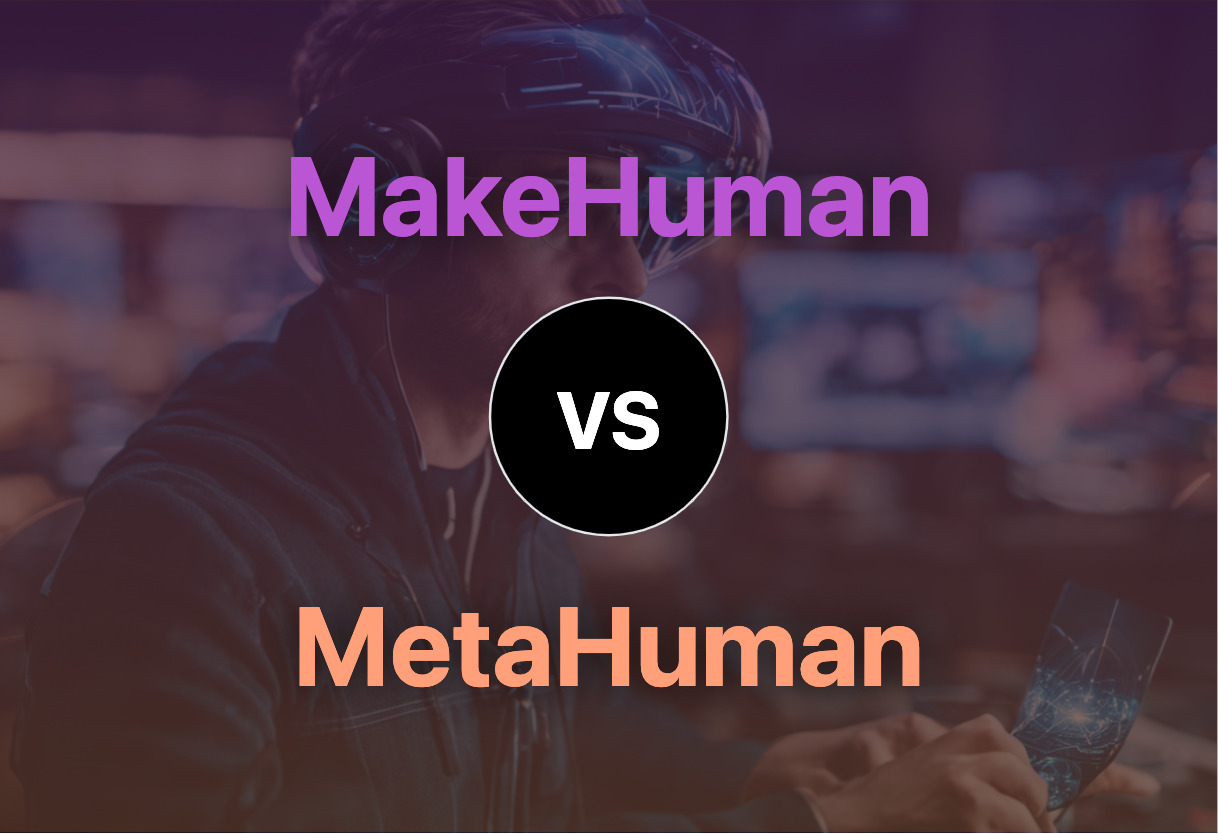For 3D modelling enthusiasts seeking cost efficiency, customization, and exportability, MakeHuman stands dominant. However, MetaHuman prevails for those focusing on superhuman traits and fantasy settings in gaming environments.

Key Differences Between MakeHuman and MetaHuman
- MakeHuman operates as an open-source tool emphasizing 3D modelling while MetaHuman focuses on enhancing character traits for game constructions.
- MakeHuman provides complex character adjustments including eye shape and finger length, whereas MetaHuman leans towards endowing characters with superhuman abilities.
- MakeHuman functions across various operating systems, but MetaHuman is primarily associated with the D&D game setting.
- While individuals can export MakeHuman’s creations to other 3D software, MetaHuman heavily connects with D&D platforms like Van Richten’s Guide to Ravenloft and Elder Evils.
| Comparison | MakeHuman | MetaHuman |
|---|---|---|
| Type of Software | 3D modeling suite | Role-playing game |
| Purpose | Creating virtual humans for professional pipelines and academic research | Designing characters with enhanced traits for game play |
| Technology | Uses parametric modeling and 3D morphing | Special characters, known as metahumans, with abilities linked to a genetic variant |
| Platform Compatibility | Linux, Mac OS X, and Windows | Dungeons & Dragons |
| Export Options | DAE, FBX, OBJ, STL formats. Integrated with Unity and other game engines | Used in horror campaigns for D&D, ranging from psychological torment to zombie/monster settings |
| Character Customization | Wide range of human attributes that can be manipulated including macro and detail | Unique abilities linked to metahuman type, can include physical alterations such as wings, gills, tail, fur, altered skin color |
| Pricing | Starts at $2 per month | Dependent on D&D game package |
What Is MakeHuman and Who’s It For?
MakeHuman is an innovative open-source tool designed primarily for creating 3D human characters swiftly. With its rich library of detailed attributes, from macro such as ethnicity to minute elements like finger length, it enhances the realism of the virtual humans. This technology is built for professionals in the CG and game industry, researchers, artists, or anyone interested in virtual reality research, visuo-haptic surgical training systems, or biomechanics.

Pros of MakeHuman
- Extensive library for swift character creation.
- Exports characters for use in other 3D software.
- Integrated with Unity and other game engines.
- Offers an innovative GUI for ease-of-use and quick access.
Cons of MakeHuman
- Priced model starting at $2 per month for additional features.
- Relies heavily on external software for detailed designs.
- Last stable release (v1.2.0) was in November 2020.
What Is MetaHuman and Who’s It For?
MetaHuman is a concept referring to individuals with enhanced traits, often linked to the genetic variant known as ‘metagene’. The metahuman universe is a confluence of conventions from gothic horror, superhero lore, and D&D’s Elder Evils. It’s tailored for aficionados of superhero mythology and D&D, those engaged or interested in alternative genetic theories, or players pursuing challenging games with fantastical entities.

Pros of MetaHuman
- Inclusive of a wide range of superhuman abilities.
- Unique capabilities for distinct variations.
- Connections to the D&D setting of Ravenloft.
Cons of MetaHuman
- Threats such as mind manipulation, soul consumption, physical transformation can deter some users.
- Exo-gene by Lexcorp for Everyman Project controversial for creating unstable heroes and power concentration.
Code Examples for MakeHuman & MetaHuman
MakeHuman
Let’s immerse ourselves in an intriguing project: a Python-driven automation script for spawning characters in MakeHuman. This presupposes an understanding of Python and the basic operation of MakeHuman. You’ll need the MakeHuman Python library installed. Let’s create a custom randomized character!
import makehuman
from makehuman import Posing, Modeling, Modifiers
# Initialize MakeHuman Application
mh = makehuman.MakeHuman()
# Load Base Model
base_model = Modeling.loadBaseModel()
# Randomize character
base_model.randomize()
# Assign new pose
pose = Posing.loadPose('assets/poses/standing01')
base_model.setPose(pose)
# Export Model as OBJ
base_model.exportObj('custom_character.obj')MetaHuman
Up next is a blueprint for utilizing MetaHuman assets in Unreal Engine 4. We’ll load a MetaHuman character and articulate a facial expression. This requires familiarity with Unreal Engine 4 and assumes the MetaHuman asset is already imported into your project.
#include "YourCharacter.h"
// Constructor function
AYourCharacter::AYourCharacter()
{
// Set this character as controlling pawn with the ability to rotate
AutoPossessPlayer = EAutoReceiveInput::Player0;
bUseControllerRotationPitch = true;
}
// Called when the game starts
void AYourCharacter::BeginPlay()
{
Super::BeginPlay();
// Load the MetaHuman character and assign it to Mesh
static ConstructorHelpers::FObjectFinder<USkeletalMesh> MetaHumanAsset(TEXT("SkeletalMesh'/MetaHumans/YourMetaHuman.YourMetaHuman'"));
if (MetaHumanAsset.Succeeded())
{
Mesh->SetSkeletalMesh(MetaHumanAsset.Object);
}
// Set facial expression
int mouthIdx = Mesh->GetMorphTargetIndex("mouthSmile_Right");
Mesh->SetMorphTarget("mouthSmile_Right", 1);
}MakeHuman or MetaHuman: Which Reigns Supreme?
Excellence in AR/VR and game development hinges upon which character creation tool you wield. Here’s the breakdown:
Open-Source Virtuosos
MakeHuman champions open-source advocates, hands down. Boasting a lower price point and broad-based compatibility – be it Linux, Mac OS X, or Windows. An innovative GUI coupled with a rapid character creation library facilitates ease-of-use and efficiency. For those coding in Python and performing complex tasks in Unity or Autodesk Maya, this is your tool.

D&D Enthusiasts
A uniquely immersive platform, MetaHuman thrives in D&D settings. It’s rife with horror campaigns and unique character traits; teleportation, physical transformation, and even soul consumption. If you’re captivated by gothic horror, and your game’s success leans on psychological torment, MetaHuman is your calling.

Research and Academia
MakeHuman extends beyond game development into academia. Its use across biomedical engineering, industrial design, facial expressions research makes it a potent tool for the intellectual community seeking scientific realism in character designs.

When choosing between MakeHuman and MetaHuman, your needs define your choice. MakeHuman excels at functionality, rich feature set, and open-source availability. If your project demands horror and superhero themes or leans towards D&D settings, MetaHuman catapults you to new heights.
Grant Sullivan
Content writer @ Aircada and self proclaimed board game strategist by day, AI developer by night.





